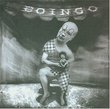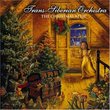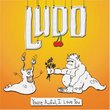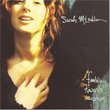| All Artists: Wolfgang Amadeus Mozart, Matyas Antal, Concentus Hungaricus, Jenö Jandó Title: Mozart: Complete Piano Concertos, Vol. 7 Members Wishing: 0 Total Copies: 1 Label: Naxos Release Date: 2/15/1994 Genre: Classical Styles: Forms & Genres, Concertos, Historical Periods, Classical (c.1770-1830), Instruments, Keyboard Number of Discs: 1 SwapaCD Credits: 1 UPCs: 730099520720, 4891030502079 |
Search - Wolfgang Amadeus Mozart, Matyas Antal, Concentus Hungaricus :: Mozart: Complete Piano Concertos, Vol. 7
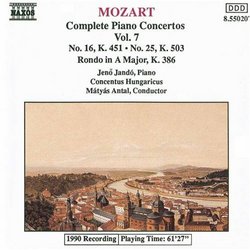 | Wolfgang Amadeus Mozart, Matyas Antal, Concentus Hungaricus Mozart: Complete Piano Concertos, Vol. 7 Genre: Classical
![header=[] body=[This CD is available to be requested as disc only.]](/images/attributes/disc.png?v=a4e11020) ![header=[] body=[This CD is available to be requested with the disc and back insert.]](/images/attributes/disc_back.png?v=a4e11020) ![header=[] body=[This CD is available to be requested with the disc and front insert.]](/images/attributes/disc_front.png?v=a4e11020) ![header=[] body=[This CD is available to be requested with the disc, front and back inserts.]](/images/attributes/disc_front_back.png?v=a4e11020) |
Larger Image |
CD DetailsSimilarly Requested CDs
|
CD ReviewsDiscovering the Mozart Piano Concertos -- K. 503 and K. 451 Robin Friedman | Washington, D.C. United States | 06/24/2004 (5 out of 5 stars) "Between February, 1784 and December, 1786, Mozart wrote twelve piano concertos which brought this form to a level seldom equaled and which constitute, in the words of Alfred Einstein, the "high-point of Mozart's instrumental composition." These twelve concertos were written for subscription concerts in which Mozart usually was the soloist. They have been recorded, together with the remaining fifteen Mozart piano concertos, by the Concentus Hungaricus conducted by Maityas Antal with Jeno Jando at the piano. These disks are available at a budget price on Naxos. Jando has recorded many works for Naxos and reminds me of Alfred Brendel and his early career recording for Vox. He focuses on the classical Vienese school -- Haydn, Mozart, Beethoven, and Schubert.This CD features the final concerto in Mozart's great group of 12, the concerto no. 25 in C Major, K.503, written in December, 1786. This concerto is probably the masterwork of the entire series, yet it remains comparatively little known. The work is very elevated in character with a tone that is both self-assured and serene. Virtuosic writing for the piano is integrated tightly with symphonic writing for the orchestra.The opening movement, allegro maestoso, is the longest opening allegro Mozart composed. It has a magisterial orchestral introduction in which the heroic opening theme alternates with passages for the winds in the minor key. The extensive piano part develops its own themes in passages that at times rival the orchestral writing in majesty and that at times are quiet and moving in their lyricism and introspection. The second movement, andante, is basically in two parts. It opens with a reserved theme stated in the orchestra which is expanded in detail by the piano. There is a brief, highly eloquent middle section, in which the piano plays alone a lyrical, innocent theme over chords in the left hand. The final movement is a rondo based on a theme Mozart borrowed from his opera, Idomeneo. The theme is developed alternately in the orchestra and the piano and features an extensive development section for the piano in combination with the winds. This is a great piano concerto similar in tone and style to Mozart's Jupiter symphony.This CD also includes an earlier work from the series of twelve concertos -- the concerto no. 16 in D. Major, K. 451, written in March, 1784. In his early study of the Mozart piano concertos, "Mozart and his Piano Concertos" (1948), Cuthbert Girdlestone described the first movement of this work as "the most powerful and most complex that Mozart has written hitherto, and one of the most powerful and complex in all his orchestral work."(p. 213) He also offered a detailed discussion of the rondo finale to this concerto (pp. 51-52) The first movement, allegro assai, opens with a lively march theme in the orchestra followed by brilliant and extended piano writing. It could be viewed almost as a predecessor for the K. 503 concerto. The second movement, andante, is a winding, sinuous theme stated first in the orchestra and repeated and embellished in the piano. It is in the form of a slow rondo and features Mozart's characteristic interplay between the piano and the winds. The third movement is a lively rondo, introduced by the orchestra with extensive development of the theme as the movement proceeds.This dis also includes Mozart's rondo in A major for orchestra and piano, K. 386. The refrain -- the rondo theme -- in the work is unusually long and lyrical. Mozart initially wrote this work as the finale for his piano concerto in A major K. 414. He then substituted another conclusion and published this work separately.I found the C major concerto here, K. 503 particularly well done. It is a work which does not have the popular appeal of many of the other Mozart concertos, but it shows the composer at the height of his powers. This disk, together with its companions, will introduce the listener to the beauties of Mozart's piano concertos." Spectacular! A Minstrel in the Gallery | Portsmouth, New Hampshire USA | 01/10/2007 (5 out of 5 stars) "This disc, like the others in this series featuring pianist Jeno Jando, is a world-class recording at a bargain price. Mozart would complete twenty-seven concertos for piano and orchestra during his lifetime, many of them the greatest works for that idiom ever created. In my opinion, no. 25 was Mozart's most symphonic effort in the genre he revolutionized during the 1780s. In many of these brilliant concertos, he pitched the piano and orchestra against each other, but in this masterwork they work together as one instrument to produce something extraordinary, even for Mozart. Concerto No. 16 is also a pleasure to hear, the first movement especially. The thoughtful rondo for piano in A major at the end of this disc is a nice extra that Jando plays wonderfully. If you love Mozart, then you should definitely get your hands on this cd." A real treat Leslie Richford | Selsingen, Lower Saxony | 01/02/2005 (5 out of 5 stars) "Today I had a real treat: after listening to Mozart?s ?Dominicus? mass performed by the Kölner Kammerchor (Cologne Chamber Choir) and the Collegium Cartusianum directed by Peter Neumann, I went on to Mozart?s Piano Concertos Nos. 16 and 25 as played by Jenö Jandó and the Concentus Hungaricus directed by Mátyás Antal (and published by Naxos as Volume 7 of its Complete Mozart Piano Concertos edition). What a many-sided genius Mozart was! Piano Concerto No. 16 (written 1784) with its trumpets, timpani and flute as well as the virtuoso piano part offers some majestic moments with a march-like opening, an andante second movement with precious woodwind colouring and a final rondo with a folksy swing to it. Concerto No. 25 (written in 1786) has a massive first movement with a theme that has been compared to Beethoven?s ?fate? theme from his Fifth Symphony. The piano is fully integrated into the orchestra in this symphonic-sounding piece, and here too there are some exciting woodwind colours to be heard. The last movement is in perfect balance and rounds off the whole perfectly. As an encore, you get a well-played Rondo in A Major K. 386 ? Naxos does not bother to tell us who completed the otherwise incomplete score.
As usual, Jenö Jandó gives a brilliant but unidiosyncratic performance. The orchestra is extremely well-captured on this disc, and it, too, sounds highly professional: compliments all round! The listener is placed right in the front row, directly beneath the centre-stage piano, and all the detail of the orchestra can be heard in exact placement. That is quite an achievement at such a budget price! My five-star evaluation is not saying that it would not be possible to outdo this recording, but it is saying that this is an excellent production that is unbeatable from the point of view of value for money. " |

 Track Listings (7) - Disc #1
Track Listings (7) - Disc #1
